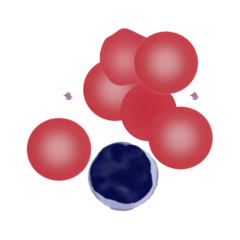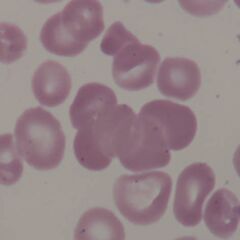Anisochromia
From haematologyetc.co.uk
Derivation: From latin “fasten with glue”
Description
Erythrocytes linked together to form irregular clumps of varying size.
Appearance: The key points are that the red cell groups are very irregular. In many cases they will include cells that have been damaged by the underlying immunological process (shown in the cartoon image as a spherocyte and irregularly contracted cell with the agglutinated group). A small image from a clinical case is shown for comparison.
Significance
Agglutinates arise when antibodies attach to antigens on the membranes of adjacent red cells linking them together. The most common cause is "cold-reactive" IgM antibodies which do not cause overt symptoms. However, in some cases the effects may be clinically significant since antibodies may activate complement causing haemolysis, or the agglutinated cells can cause occlusion of small blood vessels in the cold (acrocyanosis). The clumped cells will sediment more rapidly leading to a raised erythrocyte sedimentation rate (ESR). Finally, the antibodies that cause cold agglutination may indicate an underlying malignancy (particularly lymphoma), or by acute infection.

